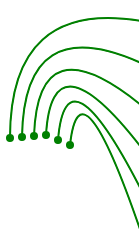Sleep plays an important role in the consolidation of memories and the removal of amyloid-β deposits via the so-called glymphathic system (GLS, see https://en.wikipedia.org/wiki/Glymphatic_system). It has now been shown by Fultz et al. (2019) that neuronal oscillations, which can be measured with the EEG, cause fluctuations in blood flow, which also set the cerebral fluid in motion. The resulting fluctuating movements of the cerebral fluid are part of the glymphatic system and cleanse the brain of deposits (e.g. amyloid-β) during sleep. Thus, a connection between EEG oscillations during sleep and the activity of the glymphathic system could be shown.
Winer et al (2019) and Lucey et al (2019) also showed that certain properties of EEG oscillations in deep sleep correlated with common Alzheimer's biomarkers (less slow oscillations in deep sleep are correlated with amyloid-β, while a weak “coupling” between slow oscillations and so-called sleep spindles is correlated with tau proteins, see Holth & Fritschi et al. (2019), and that the sleep EEG itself could be used as a biomarker in Alzheimer's disease thus.
This means that certain changes in the sleep EEG (especially in deep sleep) can reveal changes in the function of the glymphatic system. When the GLS is impaired, an increased deposition of amyloid-β takes place, which can lead to Alzheimer's disease in the long term. On the other hand, deposition of amyloid-β and tau can also lead to sleep problems, creating a vicious circle in which poorer sleep and deposition of amyloid-β and tau have a negative influence on each other and promote the development of Alzheimer's disease.
However, these findings could also lead to new treatment options. The teams around Rasch and Born al., see Muehlroth & Rasch et al. (2019) and Ngo & Born et al. (2019) showed an improved consolidation of memories by specifically influencing the subjects in different sleep phases (by cueing with odours, for example) and were able to show a balance of sleep spindles and “slow-wave-oscillations” (SWO).
For the IASON project, this research opens up undreamed-of possibilities. There is now also great interest in the sleep EEG for early diagnosis of Alzheimer's disease. A further research application should be submitted for this, if necessary, as EEG sleep measurements would exceed the resources of the IASON project in terms of time and money.
Update: In support of the above statements by Kant & Ossenkoppele, a recent Swedish study (Ärzteblatt, 2020) showed that even one sleepless night in adolescents causes a significant increase in the total tau level in the blood, see (Benedict, 2020). The consequences of this for the shaping of lifestyle, but also for sleep disturbing diseases such as sleep apnea and depression still need to be clarified in future studies. However, the results of the study may already give an indication of the different pathways of p-tau progression in AD, which Ossenkoppele writes about.
References:
- Fultz, N. E., Bonmassar, G., Setsompop, K., Stickgold, R. A., Rosen, B. R., Polimeni, J. R., & Lewis, L. D. (2019). Coupled electrophysiological, hemodynamic, and cerebrospinal fluid oscillations in human sleep. Science, 366(6465), 628–631. https://doi.org/10.1126/science.aax5440
- Winer, J. R., Mander, B. A., Helfrich, R. F., Maass, A., Harrison, T. M., Baker, S. L., Knight, R. T., Jagust, W. J., & Walker, M. P. (2019). Sleep as a potential biomarker of tau and β-amyloid burden in the human brain. The Journal of Neuroscience, 39(32), 6315–6324. https://doi.org/10.1523/JNEUROSCI.0503-19.2019
- Holth J. K., Fritschi S.K., Wang C., Pedersen N.P., Cirrito J.R., Mahan Th. E., Finn M.B., Manis M., Geerling J.C., Fuller P.M., Lucey B.P., Holtzman D.M. (2019). The sleep-wake cycle regulates brain interstitial fluid tau in mice and CSF tau in humans. Science 363 (6429), 880-884. DOI: 10.1126/science.aav2546 originally published online January 24, 2019. https://science.sciencemag.org/content/363/6429/880
- Muehlroth B.E., Sander M.C., Fandakova Y., Grandy Th. H., Rasch B., Shing Y.-L., Werkle-Bergner M. (2019). Precise slow oscillation–spindle Coupling promotes Memory Consolidation in Younger and older Adults. Scientific Reports (2019) 9:1940. https://doi.org/10.1038/s41598-018-36557-z. www.nature.com/scientificreports
- Ngo H.-V. V., Born J. (2019). Sleep and the Balance between Memory and Forgetting. Cell 179, October 3, 2019. Elsevier Inc. p. 289-291. https://doi.org/10.1016/j.cell.2019.09.007
- Lucey, B., McCullough, A., Landsness, E. C., Toedebusch, C. D., McLeland, J. S., … Holtzman, D. M. (2019). Reduced non-rapid eye movement sleep is associated with tau pathology in early Alzheimer’s disease.Science Translational Medicine, 11(474), doi: https://doi.org/10.1126/scitranslmed.aau6550
- Benedict, C., Blennow, K., Zetterberg, H., Cedernaes, J. (2020). Effects of acute sleep loss on diurnal plasma dynamics of CNS health biomarkers in young men. Neurology, https://n.neurology.org/content/94/11/e1181


 English
English  Deutsch
Deutsch